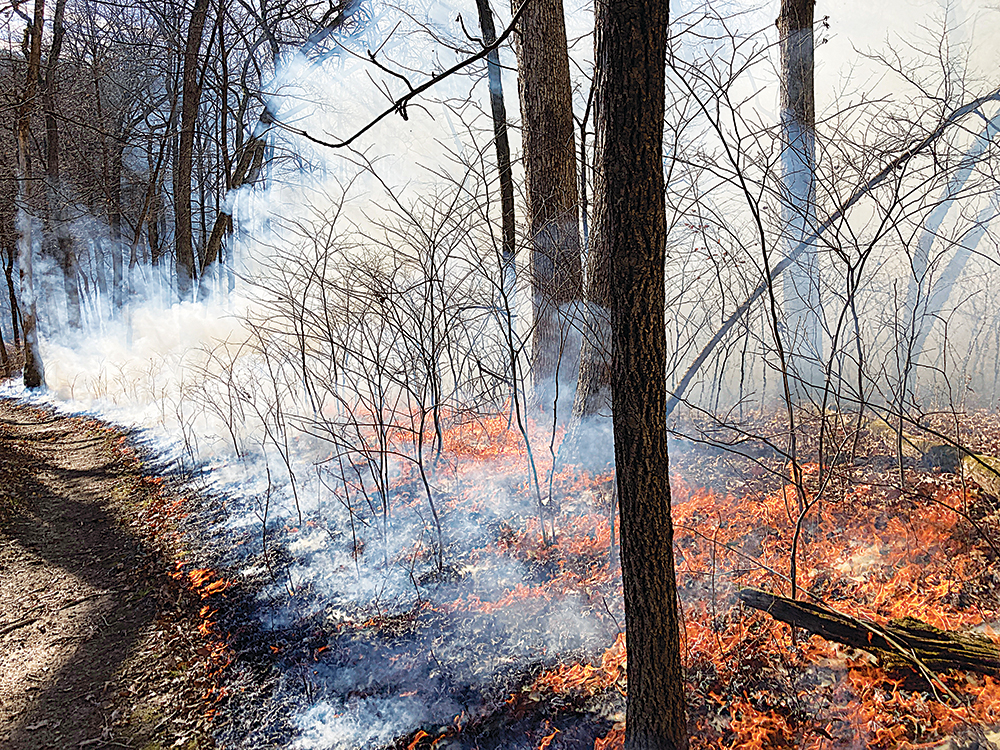
MIKE MILLER
The Peoria region is blessed with woodlands along the bluffs of the Illinois River. Many of these have been protected as conservation areas and nature preserves. Places like Forest Park, Detweiller Park, Robinson Park, Camp Wokanda and Singing Woods are all part of the Peoria Park District. Several species of oaks are the dominant trees throughout these wooded parklands. Oak woodlands are crucial habitat to many species of wildlife. Not only are the acorns an important food source for a variety of animals, the oak leaves provide crucial food for a myriad of insects, which in turn provide food for numerous birds. Oaks are what ecologists call a “keystone species.” They provide the base for a complex and diverse food chain.
The presence of oak woodlands in our region is no mere coincidence. Oak woodlands have had a strong dependence on our overall climate, topography, and other associated habitats that were found in Illinois. Ancient Illinois was a mosaic of prairies, wetlands and forests. Prairies made up more than two-thirds of the state’s ancient landscape. The wide-open areas that are now dominated by corn and soy bean fields were once made up of a diverse prairie landscape. It was once described as an inland-sea of grasses and wildflowers that, in many places, stretched from horizon to horizon. Woodlands, on the other hand, were less common and often relegated to areas with rivers, streams, and steep topography.
The dominance of our forests by oaks has a lot to do with the prevalence of prairie in the ancient landscape. Our forests were shaped by our grasslands. One of the biggest influencers of our woodlands was the prairie’s tendency to burn. When prairies dominated the landscape, fires would frequently occur when the grasses and plants become dormant after the first killing frost in the autumn and before things start to green up in the spring. These fires would move into adjacent woodlands and influence what types of trees would grow there. As oaks get older, their thick corky bark insulates them from the wildfires. Young oaks also have the ability to re-sprout from their roots if the fires were hot enough to damage young tree growth. The presence of oak woodlands today is directly tied to the fact that those forests were frequented by fire in their past. Woodlands that didn’t receive much fire in their past tend to be dominated by other species of trees such as maple and ash.
Today, the vast prairies are gone. Some of the oak woodlands remain, but they have lost their kinship with the ancient prairie. The prairie fires no longer move into the woodlands and influence the regeneration of oak trees. The ancient oaks that stand tall in the overstory are the last generation of trees that were alive when prairie dominated the landscape. With the prairies’ disappearance, we run the risk of losing the “keystone species” that has made up our forests for so long. This is a risk that has been recognized by ecologists since the early 1990’s when the USEPA developed the Midwest Oak Ecosystem Recovery Plan. Key to that plan is the reintroduction of periodic fires into oak woodlands to enhance their sustainability and resiliency.

A prescribed burn moves through Camp Wokanda last month. The Peoria Park District burned land in 40 acres of the park to remove invasive plant species and preserve oak trees. (PHOTO BY MIKE MILLER )
Locally, land managers throughout the Midwest have developed prescribed burn programs to return the ecological influence of periodic fires in oak woodlands. In mid-December, the Peoria Park District conducted prescribed burns in 40 acres of oak woodland and hill prairie habitat at Camp Wokanda. These burns help remove exotic and invasive plant species that can overpopulate woodlands and prevent oaks from regenerating. The goal is to reintroduce fire into these woodlands on a periodic basis every five to 10 years. The frequency of the prescribed burns are determined by how the forest responds to them, and how successfully the oaks regenerate. Monitoring young tree growth helps land managers determine what fire frequency is best for each woodland.
These prescribed burns move through the oak-leaf litter that is abundant on the ground in the autumn. These creeping “ground-fires” help reduce the densities of young trees that can shade out young oaks. It also helps reduce the number of exotic species such as bush honeysuckle and autumn olive. Oaks require a lot of sunlight to begin their growth from seedling to sapling. Without periodic fires, woodlands can quickly become too shaded for oaks to reach maturity.
Make sure you get out to Camp Wokanda and walk the ridge road trail from the upper parking lot. As the growing season begins in the spring, you will experience the resilience of nature as the woodlands come to life and respond to an ancient ecological influence that has always been a part of their history.
